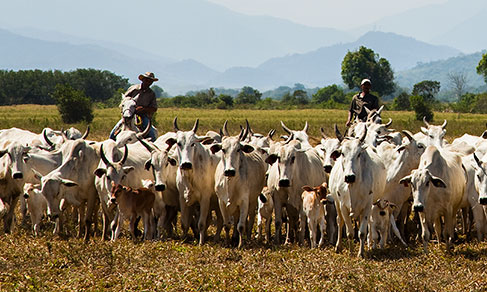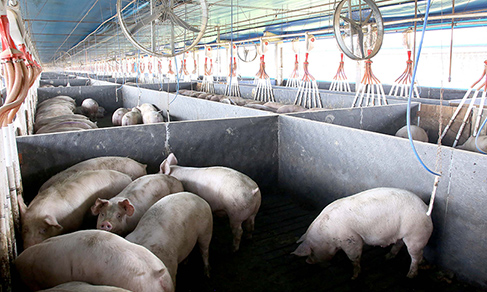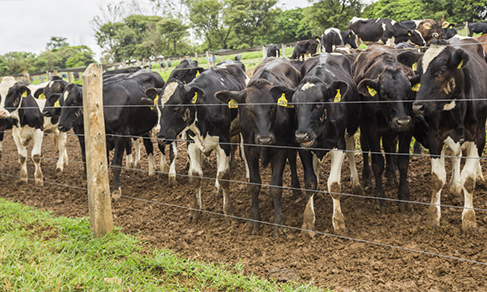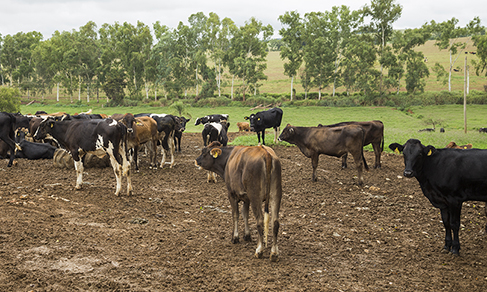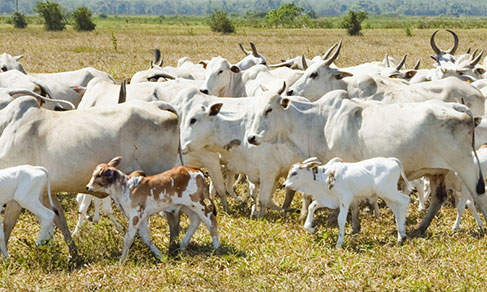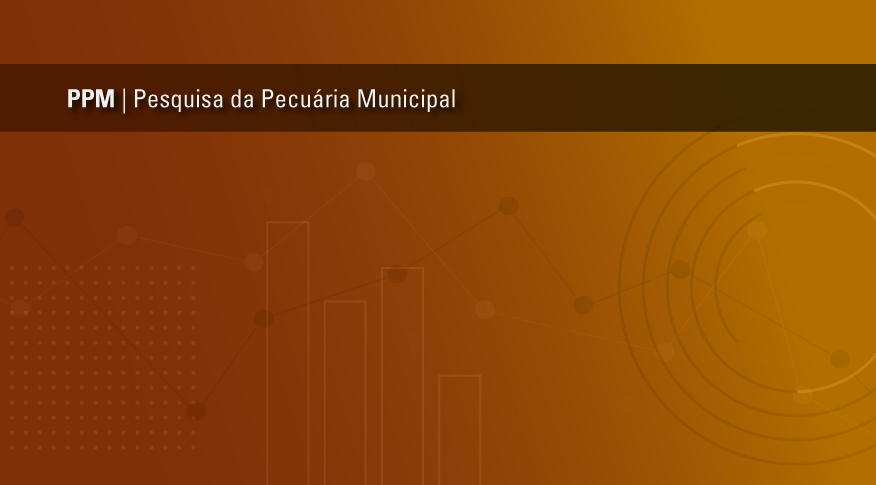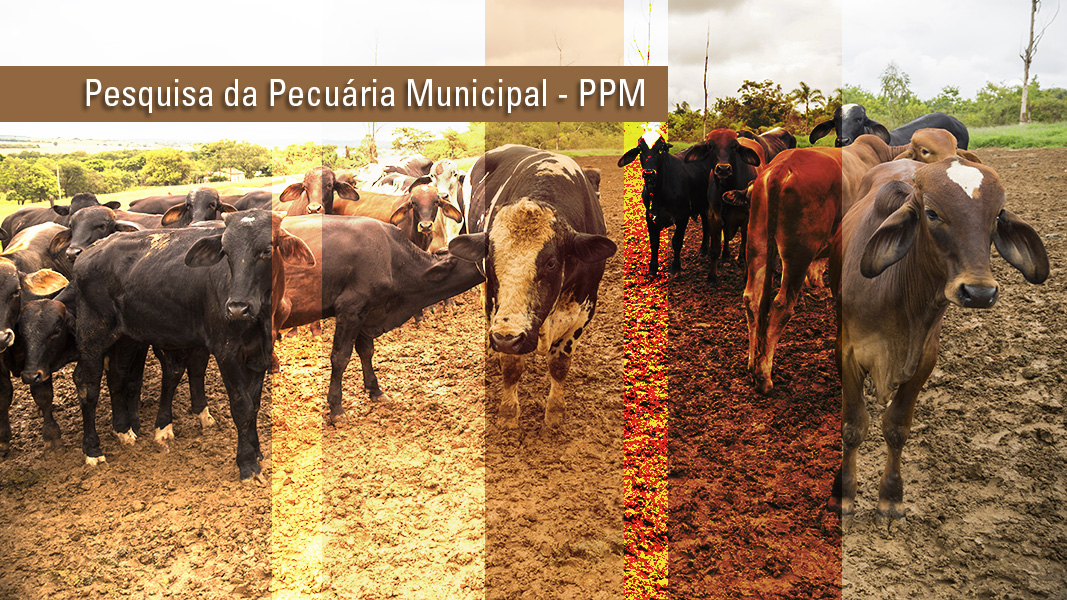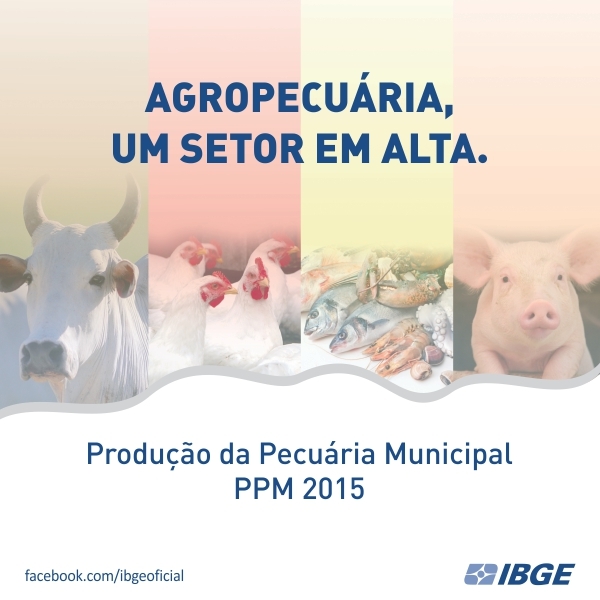Nossos serviços estão apresentando instabilidade no momento. Algumas informações podem não estar disponíveis.
PPM - Municipal Livestock Production
About - 2023
The Municipal Livestock Production Survey - PPM investigates, on an annual basis, information on the volume of animal species raised and on the production of milk, wool, hen and quail eggs, honey and silkworm cocoons, as well as on aquaculture (fish, shrimp and mollusk farming), comprising the major source of statistics on this economic segment.
This fact sheet presents general commentaries on the main results of PPM in 2023, with a highlight to the spatial distribution of the main livestock inventories and animal products in the territory, by Major Regions, Federation Units and Municipalities, and their relative participation in the total regional and national value of production, as well as the most influential factors to results. Other IBGE statistics on the topic and information from the Secretariat of Foreign Trade - Secex, of the Ministry of Economy, enrich the analyses presented and provide a comprehensive view of the Brazilian livestock production.
The IBGE also makes available the complete table plan in the IBGE System of Automatic Recovery - Sidra, which allows the construction of tables for every geographic level investigated – Brazil, Major Regions, Federation Units, Geographic Mesoregions and Microregions, and Municipalities.
Additional structural data are investigated in the Census of Agriculture, whereas short-term monitoring takes place by means of surveys conducted by the Institute every month, quarter or semester.
Information about the methodology used can be obtained in the publication Agricultural Surveys, of the Methodological Report Series..
Main results - 2023
#tabelasidra201710513459360
#tabelasidra2017105134612925
The IBGE adopts a review policy of the data disclosed by this statistical operation. Data review means any and all scheduled revision of numerical data due to new information, which was not accessible at the time of the first disclosure. For instance: late data that replaces a non-response; or data corrected by the informant himself; or a set of data that has undergone editing and imputation. For more detailed information about the published data review policy of the IBGE statistical operations, check the list of short-term, long-term and special surveys carried out by the Institute with their respective revision procedure on: https://biblioteca.ibge.gov.br/index.php/biblioteca-catalogo?view=detalhes&id=298009.
Tables - 2023
Herd inventories
Table 1 - Herd inventory, by type of herd, by Brazil, Major Regions and Federation Units
Herd inventory, by type of herd, by Federation Units, Mesoregions, Microregions and Municipalities:
- Table 2.1 - Acre
- Table 2.2 - Alagoas
- Table 2.3 - Amapá
- Table 2.4 - Amazonas
- Table 2.5 - Bahia
- Table 2.6 - Ceará
- Table 2.7 - Distrito Federal
- Table 2.8 - Espírito Santo
- Table 2.9 - Goiás
- Table 2.10 - Maranhão
- Table 2.11 - Minas Gerais
- Table 2.12 - Mato Grosso
- Table 2.13 - Mato Grosso do Sul
- Table 2.14 - Pará
- Table 2.15 - Paraíba
- Table 2.16 - Paraná
- Table 2.17 - Pernambuco
- Table 2.18 - Piauí
- Table 2.19 - Rio de Janeiro
- Table 2.20 - Rio Grande do Norte
- Table 2.21 - Rio Grande do Sul
- Table 2.22 - Rondônia
- Table 2.23 - Roraima
- Table 2.24 - Santa Catarina
- Table 2.25 - São Paulo
- Table 2.26 - Sergipe
- Table 2.27 - Tocantins
Tabela 3 - Herd inventory in the last 5 years in Brazil, Major Regions and Federation Units, by type of herd
Aquaculture production
Table 4 - Acquaculture production, by Brazil, Major Regions and Federation Units, by type of livestock production
Table 5 - Acquaculture production, by type of livestock product, by Brazil, Major Regions and federation Units
Livestock production
Table 6 - Livestock production by Brazil, Major Regions and Federation Units, by type of animal origin product
Table 7 - Livestock production, by animal origin product, by Brazil, Major Regions and Federation Units
Milked cows
Table 8 - Milked cows, by Brazil, Major Regions and Federation Units
Sheared sheep
Table 9 -Sheared sheep, b y Brazil, Major Regions and Federation Units
The IBGE adopts a review policy of the data disclosed by this statistical operation. Data review means any and all scheduled revision of numerical data due to new information, which was not accessible at the time of the first disclosure. For instance: late data that replaces a non-response; or data corrected by the informant himself; or a set of data that has undergone editing and imputation. For more detailed information about the published data review policy of the IBGE statistical operations, check the list of short-term, long-term and special surveys carried out by the Institute with their respective revision procedure on: https://biblioteca.ibge.gov.br/index.php/biblioteca-catalogo?view=detalhes&id=298009.
Concepts and methods - 2023
As informações a seguir descrevem os metadados estatísticos, que são o conjunto de conceitos, métodos e aspectos relacionados às estatísticas, e são informações necessárias para compreender as características e a qualidade das estatísticas e interpretá-las corretamente.
Informações Gerais
Objetivo
Obter informações sobre os efetivos das espécies animais criadas e dos produtos da pecuária e aquicultura em todos os municípios do País.Tipo de operação estatística
Pesquisa de pecuária e aquiculturaTipo de dados
Dados de pesquisa subjetivaPeriodicidade de divulgação
AnualPopulação-alvo
MunicípioMetodologia
No levantamento dos dados da Pesquisa da Pecuária Municipal, são considerados, para cada espécie animal ou produto pesquisado, as peculiaridades regionais, os órgãos envolvidos no setor da pecuária, os aspectos zootécnicos (raças e técnicas de criação) e ainda os recursos existentes em cada município para a realização da coleta.
As variáveis investigadas são levantadas em toda a área geográfica no município. Isso significa que além dos estabelecimentos agropecuários consideram-se também os estabelecimentos militares, coudelarias particulares ou jóqueis-clubes e quaisquer criações particulares mantidas por pessoa física ou jurídica em imóveis das zonas urbana, suburbana ou rural.
Coleta e Fontes:
A metodologia da coleta de dados baseia-se em um sistema de fontes de informações mantidas em caráter permanente, de forma a permitir um acompanhamento dos fenômenos ocorridos durante todo o ano civil.
Para as informações sobre bovinos consideram-se, entre outros, os dados sobre a Campanha da Febre Aftosa no município, mediante contatos com as Inspetorias ou Postos Veterinários responsáveis por este trabalho. Mesmo que a campanha atinja todos os estabelecimentos agropecuários da região investigada, sabe-se que os dados sobre os bovinos vacinados não representam exatamente os efetivos existentes. Ainda assim, tais informações servem de valioso subsídio à investigação.
Para a produção de leite, consideram-se as quantidades comercializadas de origem do município, em postos e usinas de beneficiamento e indústrias de laticínios; pesquisa-se também a retenção média de leite para autoconsumo dos estabelecimentos produtores e o leite comercializado diretamente a consumidores, que não sofreram resfriamento ou pasteurização.
Quanto aos suínos, obtêm-se dados da Campanha de Vacinação da peste suína (tradicional ou africana), sobre animais doentes e sacrificados no município, registrados por órgãos oficiais, informações de granjas especializadas na criação de suínos, de matadouros, indústrias e frigoríficos que trabalham com produtos suínos, e de órgãos de assistência técnica e assistência sanitária ao rebanho. Estas são as fontes mais importantes de informação.
Para aves, consideram-se as granjas avícolas existentes no município, as cooperativas de produtores, o comércio de aves e ovos e, ainda, os abatedouros.
Os dados referentes a mel de abelha são obtidos nas cooperativas de produtores e nas associações.
As informações sobre casulos do bicho-da-seda são obtidas diretamente com os produtores, pois como se trata de um número pequeno de informantes, o agente mantém um cadastro baseado no Censo Agropecuário.
Data e período de referência:
O efetivo dos rebanhos tem como data de referência o dia 31 de dezembro do ano de referência.
A produção pecuária e aquicultura tem como referência o período de 1º de janeiro a 31 de dezembro do ano de referência.
Técnica de coleta:
PAPI - Entrevista pessoal com questionário em papel, Consulta a especialistas ou registrosTemas
Temas e subtemas
Estatísticas econômicas setoriais, Agricultura, pecuária, produção florestal, pesca e aquiculturaPrincipais variáveis
- Efetivo da pecuária: bovinos; suínos; matrizes de suínos; galináceos, galinhas; bubalinos; equinos; caprinos; ovinos; codornas.- Produção de origem animal: leite, ovos de galinha, mel, lã, casulos do bicho-da-seda; além da quantidade de vacas ordenhadas e ovinos tosquiados no ano.
- Produção da aquicultura - carpa; curimatã, curimbatá; dourado; jatuarana, piabanha e piracanjuba; lambari; matrinxã; pacu e patinga; piau, piapara, piauçu e piava; pintado, cachara, cachapira e pintachara, surubim; pirapitinga; pirarucu; tambacu, tambatinga; tambaqui; tilápia; traíra e trairão; truta; tucunaré; outros peixes; alevinos; camarão; larvas e pós larvas; ostras, vieiras e mexilhões; sementes de moluscos.
- Preço médio pago ao produtor: dos produtos de origem animal levantados.
- Valor da produção da aquicultura - outros animais da aquicultura (rã, jacaré, siri, caranguejo, lagosta, etc.).
Unidades de informação
Unidade de investigação
MunicípioUnidade de análise
MunicípioUnidade informante
Pessoa, Empresa, Estabelecimento, Órgão da Administração Pública, Entidade sem fins lucrativos.Períodos de referência
Data de início da coleta
02/01/2024Disseminação
Formas de disseminação
Banco de Dados Agregados - SIDRA, Publicação Digital (online), Publicação impressa, Banco Multidimensional de Estatísticas - BMENível de desagregação geográfica
MunicípioNível de divulgação
A divulgação dos dados é feita em nível Brasil, Grandes Regiões, Unidades da Federação, Mesorregiões, Microrregiões Geográficas e Municípios.Instrumentos de coleta
Histórico
Em 17/01/74, pelo Decreto nº 73.482, o IBGE passou a responsabilizar-se por todas as fases da pesquisa. A pesquisa passou então a denominar-se "Produção da Pecuária Municipal". Até 1980, as variáveis pesquisadas para bovinos eram: rebanho bovino, vacas ordenhadas, leite de vaca, utilização predominante da criação (corte ou leite), touro reprodutor, boi de trabalho, boi para corte, novilho para corte, vaca leiteira, vaca de cria, vaca velha, novilha, bovino (entre 1 e 2 anos), bovino (menor de 1 ano) e leite de vaca. Para suínos, eram levantadas até 1980 as seguintes variáveis: rebanho suíno, macho reprodutor, porca criadeira, leitões e outros porcos e porcas. Para galináceos, levantava-se o efetivo de galinhas, juntamente com galos, frangas, frangos e pintos. A finalidade predominante (corte ou postura) dos galináceos constou até 1980, bem como ovos de outras aves (patas, marrecas, gansas e peruas).
Em 1981, as principais mudanças ocorridas no questionário referiram-se à classificação do rebanho bovino que passou a coletar informações para as classes: menores de 1 ano, de 1 a menos de 2 anos e de 2 anos e mais (touros reprodutores, vacas e outros). Já os suínos, passaram a ter as informações coletadas segundo as classes: menores de 6 meses e de 6 meses e mais.
A partir de 1989, a pesquisa foi renomeada como "Pesquisa da Pecuária Municipal", tendo sido modificado o questionário em seu conteúdo. As principais alterações introduzidas foram com relação ao rebanho bovino, que passou a ser investigado por uma classe única; os suínos, que passaram a ter a coleta pelas seguintes categorias: porcas criadeiras e outros porcos e porcas; e, finalmente, destaca-se que o levantamento dos preços médios pagos ao produtor das espécies animais foram abolidos.
Em 2013, o questionário foi novamento modificado, deixando de investigar os efetivos de asininos, coelhos e muares. A variável "porcas criadeiras" foi renomeada para "matrizes de suínos", e a "outros porcos e porcas" foi eliminada. Foi criada a variável "suínos", que engloba todo o efetivo desta espécie, incluindo as "matrizes de suínos". A variável "galos, frangos, frangas e pintos" foi substituída por "galináceos', que corresponde ao efetivo total desta espécie. Desse modo, ocorreu mudança nos ítens do questionário. Primeiramente, pergunta-se para suínos e galináceos, o efetivo total dessas espécies e depois os efetivos de "matrizes de suínos" e de "galinhas". A pesquisa inclui a produção de animais aquáticos em cativeiro - aquicultura - tanto de água doce ou salgada, em áreas particulares ou públicas.
Saiba mais
https://metadados.ibge.gov.br/consulta/estatisticos/operacoes-estatisticas/PPPublications - 2023
Produção da pecuária municipal
Material type: Journal
Year: 1973-
Description
The survey investigates information on animal farming inventories and livestock products, having the municipality as the data collection unit.
The Municipal Livestock Production Survey - PPM began in the Ministry of Agriculture in 1945. The data were raised by the IBGE Data Collection Network and the Ministry of Agriculture developed the questionnaires, compiled the survey, edited it and disclosed the results. With Decree no. 73,482, of January 17, 1974, the IBGE became in charge of all the phases of the survey from that date onward, as well as of the other statistical surveys related to the agricultural sector. Nevertheless, the statistics related to the years of 1971 and 1972 are not available, since they were not released by the Ministry. Up to 1980, the variables investigated were, basically, the amount of animals existing on December 31, the output of the major primary products of livestock and the average annual unit price The survey questionnaire had its scope improved in 1981 and 1989. In addition to other improvements in the questionnaire in 2013, the output of aquaculture began to be investigated, as a result of an agreement between the IBGE and the Ministry of Fishing and Aquaculture. The production of fish, shrimp and shellfish, fingerlings, shrimp larvae and shellfish seeds, as well as the value of the production of other animals (frogs, alligators, etc.) were then introduced in the PPM.
The survey provides information on the livestock inventories existing in the municipality on the reference date of the survey, as well as on the production of animal origin and the value of the production during the reference year. The inventories include cattle, pigs and hogs, pig matrices, poultry, hens, quails, horses, buffaloes, goats and sheep. The production of animal origin, on turn, includes the output of milk, hen eggs, quail eggs, honey, greasy wool and cocoons of silkworm; the amount of milked cows and sheared sheep; and aquaculture, which includes fish farming, shrimp farming and malacoculture.
The periodicity of the survey is annual. The geographic coverage is national, with results released for Brazil, Major Regions, Federation Units, Mesoregions, Microregions and Municipalities.
Time series
#seriehistorica201783144017110
#seriehistorica2017105135854749
Downloads
Technical Information
- -#notas tecnicas pam pevs ppm pamclo (en)
- -#notas tecnicas pesquisa trimestral do abate leite couro ovos de galinha estoques pam pevs ppm pamclo lspa (en)
- -#Informações técnicas PPM (en)
Survey methodology (Methodological Reports Series, v. 3)
Survey methodology (Survey methodology, v. 6)
- Survey methodology, 3rd ed., 2018
- Survey methodology, 2nd ed., 2002
- Survey methodology, 1st ed., 1989
The changes that take place after the release of the methodological reports are presented as Tecnical notes. Up to 2016, those notes comprised a full chapter of the results publication and, from 2017 onward, they are released apart. You can see them on the following address: https://www.ibge.gov.br/estatisticas/economicas/agricultura-e-pecuaria/9107-producao-da-pecuaria-municipal.html?=&t=publicacoes
News and Releases
Production value of livestock and acquaculture reaches R$ 132.8 billion 2024, with production record in milk, hen eggs and honey
The production value in the 2024 PPM reached R$132.8 billion, an increase of 8.8% compared to the previous...
18/09/2025
Herds and value of products of animal origin hit record in 2022
In 2022, the cattle herd grew for the fourth consecutive year and reached a new record in the time series,...
21/09/2023
In 2021, cattle herd hits record figure and reaches 224.6 million head
Cattle herd hits a record in 2021 and reaches 224.6 million head Cattle herd increased for the third...
22/09/2022
Cattle slaughter declines 8.2% and chicken slaughter falls 1.2% in Q4, but slaughter of hogs and pigs grows 5.8%
The slaughter of cattle fell by 8.2% and that of chickens by 1.2%, while that of pigs and hogs rose by...
10/02/2022
PPM 2020: cattle herd is 1.5% bigger and amounts to 218.2 million head
In 2020, national cattle herd grew by 1.5% and reached 218.2 million head, biggest amount since 2016....
29/09/2021
Cattle herd increases by 1.5%, with a total of 218.2 million head in 2020
Cattle herd increased for the second consecutive year in 2020, after two years of decrease, according...
29/09/2021
PPM 2019: after two years of decrease, cattle herd size increases by 0.4%
National cattle herd recovers after two straight years of decrease. With a slight increase (0.4%) in...
15/10/2020
Cattle herd records slight increase in 2019, after two straight years of decrease
Cattle herd increased in 2019, after two straight years of decrease, according to the Municipal Livestock...
15/10/2020
2017 PPM: Cattle herd prevails in Central-West, Mato Grosso leads states
The national volume of cattle was of 214.9 million herd in 2017, representing a reduction of 1.5% over...
27/09/2018
PPM: cattle herd reaches a record 215.2 million head, whereas milk output falls 0.4%
Cattle herd totaled 215.2 million head in 2015, a record figure, 1.3% higher than...
29/09/2016
Errata
Data review of the Municipal Livestock Survey 2014 to 2021
Published date: 19/09/2024
Description:
Correction of data in the Municipal Livestock Survey from 2014 to 2021.
Poultry: The number of poultry in Cascavel was overestimated from 2018 onwards. A meeting with the Department of Rural Economy (Deral) of Paraná was held to fix these estimates.
Malacoculture: Production in Rio Grande do Norte had not been recorded by the IBGE in previous years, but with the collaboration of the Ministry of Fisheries and Aquaculture - MPA, this omission was corrected.
Additional data reviews were carried out on other products in the period from 2014 to 2021, as shown in the table below:
YEAR FU AGENCY MUNICIPALITY PRODUCT 2018 to 2021 PR Cascavel Cascavel Poultry (heads) 2017, 2018 and 2021 RN Santo Antônio Tibaú do Sul Oyster seeds (thousands) 2014 to 2021 SC Itajaí Ilhota Fingerlings (thousands) 2021 SC Florianópolis Florianópolis Oysters, scallops and mussels (kg) 2019 to 2021 SC Itajaí Ilhota Tilapia (kg) 2021 SC Itajaí Penha Shrimp (kg) 2021 SC Palmitos Caxambú do Sul Tilapia (kg) 2021 SC Palmitos Cunhataí Tilapia (kg) 2021 SC Palmitos São Carlos Tilapia (kg) 2021 SC São José Angelina Cow's Milk (liters) 2021 SC São José Angelina Milked Cows (head) 2021 SC São José Garopaba Oysters, scallops and mussels (kg) 2020 and 2021 SP Fernandópolis Estrela D'oeste Milked Cows (head) 2020 and 2021 SP Fernandópolis Estrela D'oeste Cow's Milk (liters) 2020 and 2021 SP Fernandópolis Fernandópolis Milked Cows (head) 2021 SP Fernandópolis Fernandópolis Leite de Vaca (litros) 2020 and 2021 SP Fernandópolis Indiaporã Milked Cows (head) 2020 and 2021 SP Fernandópolis Macedônia Milked Cows (head) 2020 and 2021 SP Fernandópolis Meridiano Milked Cows (head) 2021 SP Fernandópolis Meridiano Cow's Milk (liters) 2020 and 2021 SP Fernandópolis Mira Estrela Milked Cows (head) 2020 and 2021 SP Fernandópolis Ouroeste Milked Cows (head) 2020 and 2021 SP Fernandópolis Pedranópolis Milked Cows (head) 2020 and 2021 SP Fernandópolis São João das Duas Pontes Milked Cows (head) 2021 BA Ibotirama Muquém de São Francisco Tilapia (kg) 2020 and 2021 CE Crato Santana do Cariri Honey (kg) 2021 AM Humaitá Apuí Cattle (head) 2021 AM Humaitá Boca do Acre Cattle (head) 2021 AM Lábrea Canutama Cattle (head) 2021 AM Humaitá Novo Aripuanã Cattle (head) 2021 AM Lábrea Lábrea Cattle (head) 2021 AM Lábrea Tapauá Cattle (head)
Actions: The files were corrected and replaced in the SIDRA and BME databases and on the IBGE PortalRevision of data - Municipal Livestock Production 2013 to 2020
Published date: 21/09/2023
Description:
Correction of information in the Municipal Livestock Survey between the years of 2013 and 2020, as seen below:Shellfish seeds: Revision of the series (2013 to 2020) of the product “shellfish seeds”, in the municipality of Florianópolis, with the support from the Shellfish Laboratory of the Federal University of Santa Catarina.
Besides the descriptions above, revisions of data of other products were necessary between the years of 2018 and 2020.
Revised data:
YEAR UF MUNICIPALITY PRODUCT 2013 to 2020 SC Florianópolis Shellfish Seeds 2019 to 2020 RJ São Fidélis Tilapia 2018 RJ Nova Friburgo Quail eggs 2018 to 2020 RJ Rio de Janeiro Hen eggs 2020 RJ Quatis Tilapia 2019 and 2020 PE Jatobá Tilapia 2020 CE Baturité Honey Actions: The files were corrected and replaced at the SIDRA and BME databases and on the IBGE website.
Data revision of Municipal Livestock Production 2013 to 2019
Published date: 22/09/2022
Description:
Information of the Municipal Livestock Production between 2013 and 2019 has been amended as follows:
Fish farming: Revision in the time series of the product "other fishes", having noticed that some species of fish included in the variable "other fishes" between the years of 2013 and 2019 were already part of the questionnaire. The output was committed to the correct species.
Shrimp farming: Due to the specific survey on shrimp farming in the State of Ceará in 2022, data for the year of 2019 needed to be revised.
In addition to the above changes, data of same other products related to 2019 and collected in 2020 were revised, due to the COVID-19 pandemic, when the data collection was jeopardized in some Municipalities as it was impossible to contact part of the informants.
Actions: The files have been amended and replaced in the SIDRA and BME database and in the IBGE Portal.Data review on the cattle inventory for the municipality of São Félix do Araguaia (MT) in the 2019 Municipal Livestock Production
Published date: 26/10/2020
Description:
Change in the result of the cattle herd in the municipality of São Félix do Araguaia (MT).Actions: The SIDRA data on the cattle inventory was altered in the 2019 Municipal Livestock Production.
Error in the release date of the 2019 Municipal Livestock Production
Published date: 10/08/2020
Description:
The IBGE identified non-compliance with the release date of the results of the 2019 Municipal Livestock Production, as highlighted on the portal on January 2 of 2020. Due to the data collection delay provoked by the COVID-19 pandemic, the dissemination of the results was postponed until October 15, 2020.Actions: The release calendar was changed.
Infographic revision in the Municipal Livestock Production 2017
Published date: 10/10/2018
Description:
Modification of the infographic on page 8 of the fact sheet, relative to the production of shrimp. The images of maps of the states of Ceará and Rio Grande do Norte had been swapped.
Actions: Modification of the infographic relative to shrimp production in the survey of Municipal Livestock Production 2017 fact sheet.




